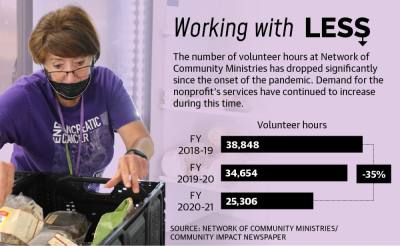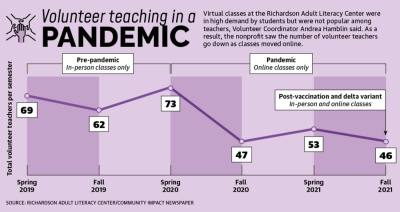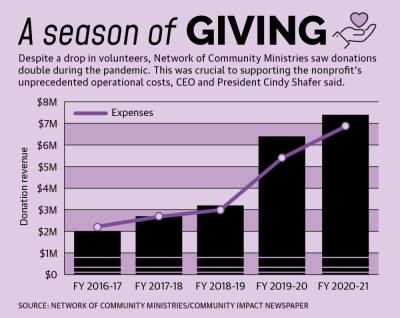“Pivoting amid the upheaval has been the name of the game,” Smith said. “When the pandemic started, we shut down ... which ground our production to a halt right as the need was going to become greater than ever.”
Almost two years into the pandemic, nonprofit leaders in Richardson say demand for their services continues to skyrocket. The rapid rate of inflation is driving up the cost of basic necessities, such as gas and food, which is straining families, said Cindy Shafer, CEO and president of Network of Community Ministries.
“The number of new families coming to us is incredible,” she said. “Historically, we serve the working poor, and we have many people that just can’t make ends meet.”
Heading into 2022, nonprofit leaders are working to debunk the notion that the need for their services went away when the economy reopened and vaccines were released.
“I’m concerned ... because the need keeps increasing, which means the dollars that we need to support that need keeps increasing,” Shafer said, noting that donations to Network have stabilized in recent months.
A surge in demand
During the pandemic, the number of families served weekly by Network climbed from 150 to 750, Shafer said.
“We are back up to serving about 500 families a week in person ... and several hundred families per week with the Mobile Food Pantry,” Shafer said. “So, we are at those heights of 700 to 800 families a week ... and that’s just crazy to me.”
Since opening in July 2018, roughly 163,000 volunteers at Feed My Starving Children’s Richardson facility have packed about 43 million meals, Smith said. But, due to the pandemic, the organization has reduced each volunteer session’s room capacity to 30%.
“The need is great,” Smith said. “Our partners reach out to us and say, ... ‘We will take as much as you can make as fast as you can send it.’”
Food-focused organizations are not the only groups experiencing heightened demand. The Warren Center, a nonprofit that serves children and families affected by developmental delays, saw referrals for its services skyrocket once physician’s offices and child care centers reopened.
“Now that kids are going back to school, to day care and to doctor’s offices ... we are seeing an influx of kids who we probably could have seen a year [ago],” Chief Marketing Officer Asriel Eford said.
The city’s Volunteer Assistance Program also saw its services affected by the crisis. The program pairs volunteer agencies with residents who need help maintaining their property. Its typical clients are seniors or residents who are disabled, but a new group of individuals emerged as a result of the pandemic, Community Services Administrator Lindsay Turman said.
“COVID[-19] brought out a new set of people, which are people who have simply not been working and can’t afford to make improvements,” Turman said, noting the program receives between 60-100 requests for assistance each year.
Volunteer shortages
Amid the surge in demand, nonprofits are working to restore pre-pandemic volunteer levels.
A 2020 survey done by United Ways of Texas and the OneStar Foundation, in partnership with the Center for Nonprofits & Philanthropy at Texas A&M University, found that nearly 60% of nonprofits experienced severe decreases in volunteers due to COVID-19. Representatives from nonprofits throughout Richardson said that drop continued in 2021.
“The number of students we are able to serve is directly correlated to the number of volunteers that we can recruit to teach our classes,” said Sonali Patnaik, director of the Richardson Adult Literacy Center. “There were students we couldn’t serve that would have liked to have our services.”
The number of volunteer English teachers at the center is the lowest it has been since the onset of the pandemic. This fall, 46 teachers signed up to serve 206 students. This represents a 26% drop in teachers from fall 2019.
Volunteer Coordinator Andrea Hamblin said much of the decrease can be attributed to the center’s adoption of virtual classes.
“Teachers who had pledged to teach in person because that’s the format they preferred were later unable to commit because of [concerns about] the delta variant,” she said. “They didn’t feel comfortable teaching online.”
Shafer said concerns around the pandemic caused Network to lose about three-quarters of its volunteers, many of whom were seniors at high risk for contracting the virus. The organization hired more paid employees to bridge the gap, she said.
“They weren’t comfortable coming out to serve ... but the work has to get done,” she said.
Kathy Wilson has been volunteering with Network for the past two years. After retiring from a 30-year career with Texas Instruments, Wilson said she felt compelled to give back.
“I’ve been blessed in my life,” she said. “It warms my heart to be able to help others.”
Despite its shortage of volunteers, Network saw an increase in donations during the pandemic, Shafer said. Donations doubled between fiscal years 2018-19 and 2019-20, from $3.2 million to $6.4 million.
“While our need has increased greatly, the community has seen that need and so far [has] been able to meet it,” she said.
Colleen Campbell, executive director of The Assistance Center of Collin County, said her agency has seen a more than 70% drop in volunteers. The nonprofit offers financial assistance programs and works to prevent homelessness. After operating with about 35 volunteers per week pre-pandemic, Campbell said the organization now has fewer than 10 volunteers per week, and only half volunteer in person.
“Nonprofits run on tight budgets, and if I have to pay someone [to assist with operations], that’s money I can’t [use to] help a client that’s in need,” Campbell said.
The Assistance Center also saw a rise in donations last year, but that has tapered off in 2021, Campbell said.
“Now [that] we’re in year two [of the pandemic], I think a lot of people who are not as close to it think that maybe people aren’t in need as much,” she said. “But we are still seeing a great need for assistance.”
The biggest needs
Many nonprofits in and around Richardson are preparing for increased need during the holiday season.
“We desperately need in-person volunteers to come and help us sort, pack and do all of those [things the food bank] needs,” said Cassie Collins, director of Volunteer Operations for the North Texas Food Bank. “We need to be able to get out as much product as possible so that everyone has a wonderful holiday season.”
Holiday food items and new, unwrapped toys are among Network’s biggest needs. But Shafer said volunteers in the Clothing Closet are where Network requires the most help.
“Our Clothing Closet is hugely short on volunteers, and we have talked about having to cut back hours if we don’t get more volunteers,” she said.
Smith said small donations to Feed My Starving Children go a long way.
“Each meal only costs $0.24,” she said. “So, when you think of it from that perspective, every penny really does count.”
Campbell said significant demand also remains at The Assistance Center, despite people returning to work.
“People that are working are not getting the hours they were making prior [to the pandemic], so they’re still in need of help with their rent and utilities,” she said. “We are seeing families get evicted. That’s not something we want to see, ever.”
William C. Wadsack contributed to this report.








